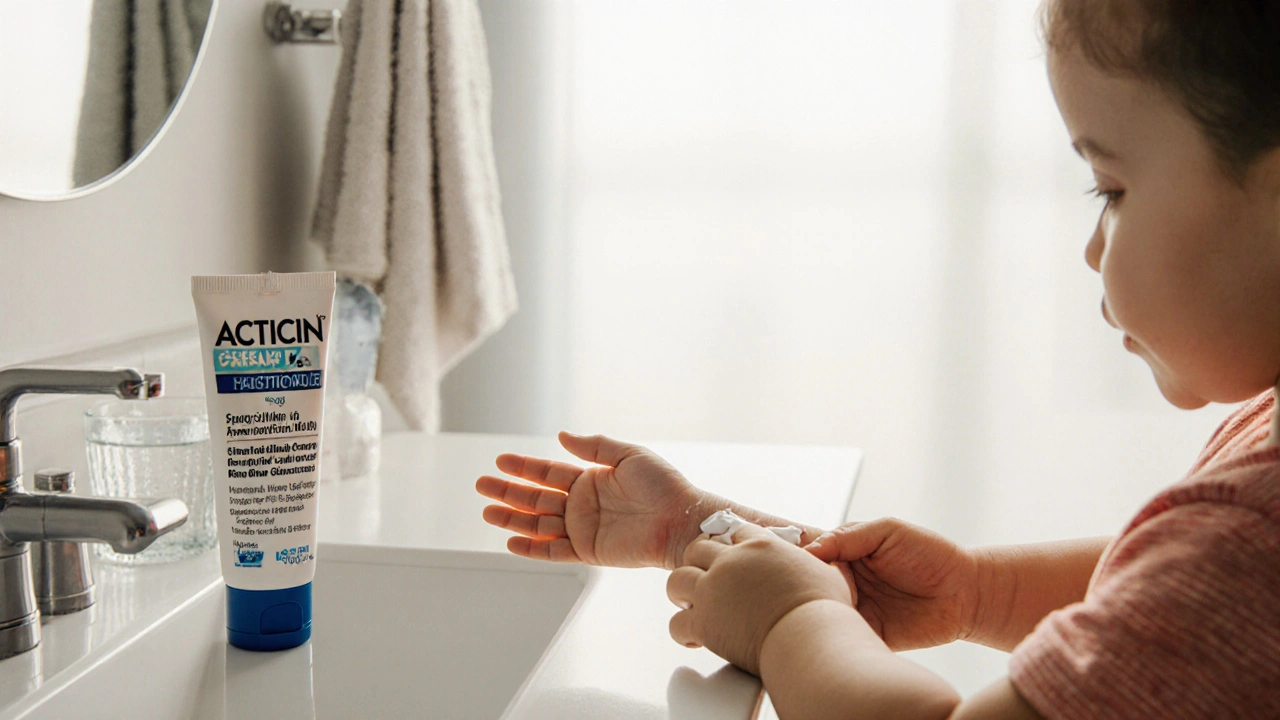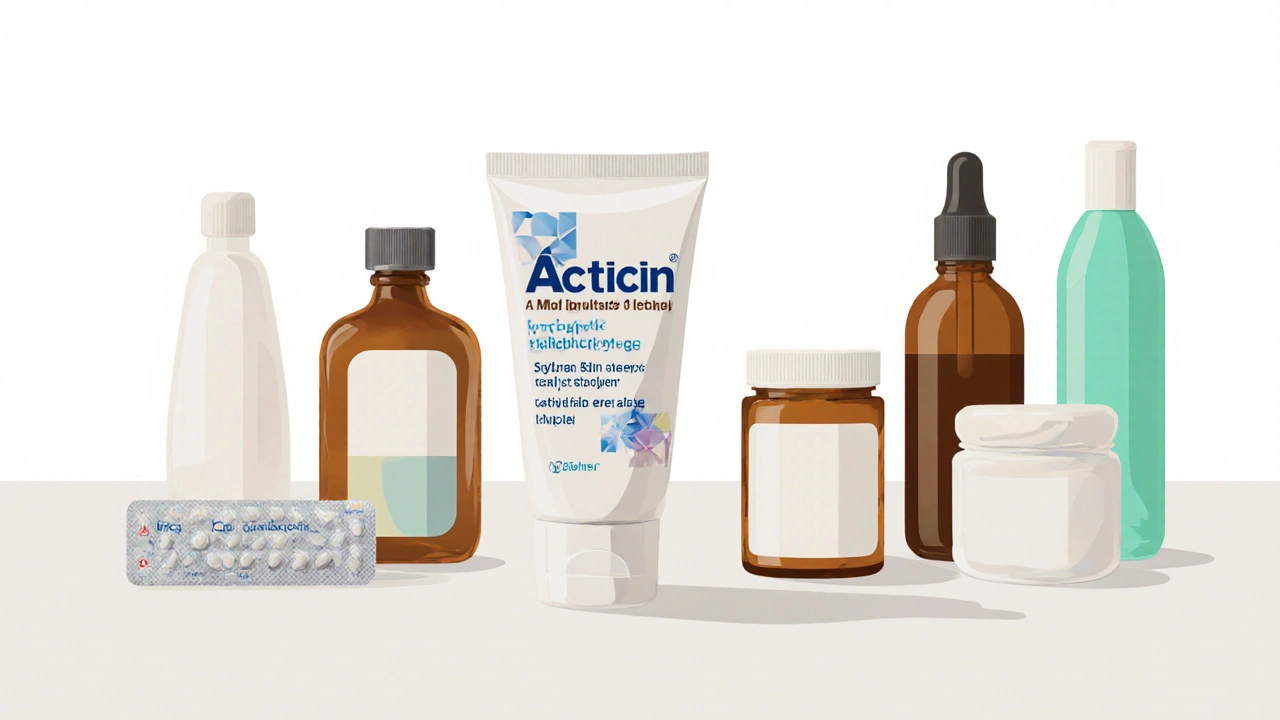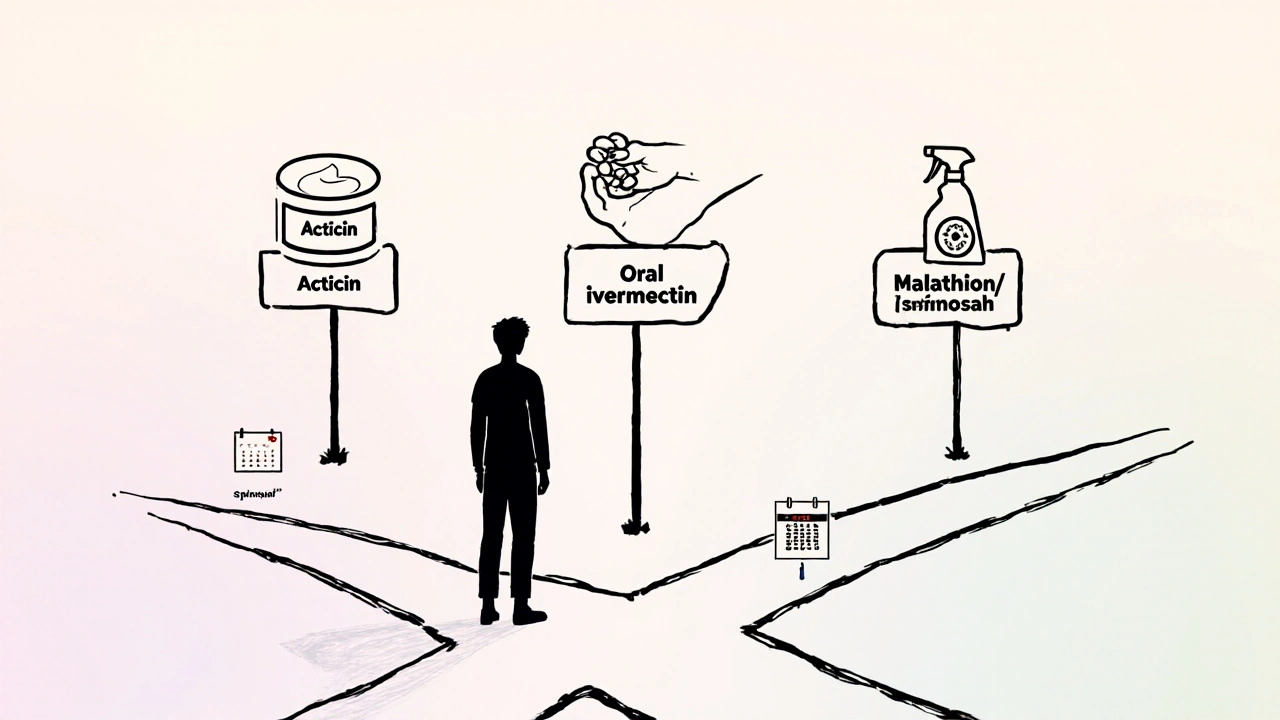Acticin (Permethrin) vs. Alternative Treatments: Which Is Best?

Acticin vs. Alternative Treatments Decision Guide
When you need to get rid of scabies or head lice, the market is crowded with creams, lotions, and sprays. Acticin is often the first name that pops up, but dozens of other products claim to work just as well-or even better. This guide cuts through the hype, compares Acticin (permethrin) with the most common alternatives, and helps you pick the right option for your situation.
Quick Takeaways
- Acticin (permethrin) is a synthetic pyrethroid that kills mites and lice by disrupting their nerve cells.
- Topical ivermectin and oral ivermectin are the most effective for stubborn scabies.
- Malathion and spinosad are popular for head‑lice cases where resistance to permethrin has emerged.
- Prescription status, safety profile, and treatment duration vary widely among alternatives.
- For most first‑time, uncomplicated cases, Acticin remains a convenient, safe, and cost‑effective choice.
What Is Acticin (Permethrin)?
Acticin is a permethrin‑based cream approved for the treatment of scabies and head lice. The active ingredient, Permethrin, belongs to the synthetic pyrethroid family and works by keeping neural sodium channels open, causing paralysis and death of the parasite. In most countries, Acticin is available over‑the‑counter in a 5% concentration, applied for 8-12hours before washing off.
Key Alternatives to Consider
Below are the most widely used alternatives, each with its own strengths and drawbacks.
Ivermectin (Topical & Oral)
Ivermectin is a macrocyclic lactone that interferes with the parasite’s glutamate‑gated chloride channels. It’s available as a 0.5% cream (topical) and as a single oral dose of 200µg/kg. Clinical trials report >95% cure rates for scabies, even in cases resistant to permethrin.
Benzyl benzoate
Historically the go‑to scabies treatment, benzyl benzoate is an oil‑based lotion applied twice over 24hours. It irritates the skin, which can make compliance difficult, but it remains cheap and effective when used correctly.
Malathion
Malathion is an organophosphate insecticide used primarily for head‑lice eradication. It works by inhibiting acetylcholinesterase. A 0.5% lotion applied for 8hours can clear up to 90% of resistant lice populations.
Lindane
Lindane (γ‑hexachlorocyclohexane) is a potent neurotoxin once common for scabies. Due to high neurotoxicity and environmental concerns, its use has been restricted in many regions, but it’s still listed in some OTC kits.
Crotamiton
Crotamiton is a dual‑action agent that both kills mites and provides antipruritic relief. It’s applied as a 10% cream twice daily for 5days. Cure rates hover around 80%, making it a modest option for mild cases.
Spinosad
Spinosad is a bacterial‑derived insecticide used for head lice. The 0.9% shampoo kills lice within 30minutes, and a single treatment often suffices even when resistance to permethrin is present.
Pyrethrins
Derived from chrysanthemum flowers, pyrethrins are the natural counterpart to synthetic permethrin. They’re less stable in sunlight and can cause allergic reactions, but they’re still marketed in some lice shampoos.

Side‑by‑Side Comparison
| Product | Active Ingredient | Formulation | Prescription Status | Typical Use | Average Efficacy | Safety / Common Side‑Effects |
|---|---|---|---|---|---|---|
| Acticin | Permethrin 5% | Cream | OTC in most markets | Scabies, head lice | ≈85‑90% (first‑line) | Mild skin irritation, rare allergic reaction |
| Ivermectin (topical) | Ivermectin 0.5% | Cream | Prescription in many regions | Scabies (esp. resistant) | ≈95%+ | Transient redness, rarely systemic effects |
| Ivermectin (oral) | Ivermectin 200µg/kg | Tablets | Prescription | Severe or crusted scabies | ≈95%+ | Headache, nausea; rare neurotoxicity |
| Benzyl benzoate | Benzyl benzoate 25% | Lotion | OTC | Scabies | ≈80‑85% | Intense burning, dermatitis |
| Malathion | Malathion 0.5% | Lotion | OTC (some regions) | Head lice | ≈90% (resistant cases) | Scalp irritation, rare systemic toxicity |
| Lindane | Lindane 1% | Shampoo | Prescription only in many countries | Scabies | ≈85% (when used correctly) | Neurotoxic reactions, skin irritation |
| Crotamiton | Crotamiton 10% | Cream | OTC | Scabies (mild) | ≈80% | Itching relief, occasional rash |
| Spinosad | Spinosad 0.9% | Shampoo | OTC | Head lice | ≈95% (including resistant strains) | Mild scalp itching, rare allergy |
| Pyrethrins | Pyrethrins blend | Lotion / Shampoo | OTC | Head lice | ≈70‑80% (resistance common) | Skin irritation, rare allergic reactions |
When Acticin Is the Right Choice
If you’re dealing with a first‑time, uncomplicated scabies outbreak or a mild lice infestation, Acticin checks most boxes: it’s inexpensive, easy to apply, and has a long safety record. The 8‑hour leave‑on time fits most daily routines, and the odds of severe side‑effects are low. For families with young children, the cream’s low irritation profile often outweighs the need for prescription‑only options.
Scenarios Where Alternatives Shine
- Resistant scabies or crusted (Norwegian) scabies: Oral or topical ivermectin offers the highest cure rates.
- Severe skin sensitivity: Crotamiton provides antipruritic benefits with minimal irritation.
- Known permethrin resistance in lice: Malathion or spinosad are the go‑to treatments.
- Regulatory constraints: In regions where permethrin is banned (some parts of Australia for livestock), benzyl benzoate or lindane may be the only legal options.
Safety and Precautions Across All Products
Regardless of the brand you pick, follow these universal rules to minimize risks:
- Read the label thoroughly-especially the recommended contact time.
- Perform a patch test on a small skin area 24hours before full application.
- Avoid using multiple scabicidal agents simultaneously; they can interact and increase irritation.
- Wash bedding, clothing, and towels in hot water (≥60°C) after treatment to prevent re‑infestation.
- For pregnant or breastfeeding individuals, consult a healthcare professional before using prescription‑only options like ivermectin or lindane.

How to Choose the Best Treatment for You
Use the decision flow below to narrow down the optimal product:
- Identify the parasite: Scabies vs. head lice.
- Assess severity: Single‑site rash or a few lice vs. widespread infestation or crusted scabies.
- Check for previous treatment failures: If permethrin didn’t work, move to ivermectin, malathion, or spinosad.
- Consider age and skin condition: Children under 2years often need milder agents like crotamiton.
- Review prescription requirements: If you cannot see a doctor quickly, stick with OTC options (Acticin, benzyl benzoate, malathion, spinosad).
Cost Overview (2025 Prices - Australia)
- Acticin 5% cream (30g): AU$8‑12.
- Ivermectin cream 0.5% (20g): AU$25‑35 (prescription).
- Oral ivermectin tablets (3mg, pack of 2): AU$30‑45 (prescription).
- Benzyl benzoate lotion (30ml): AU$6‑9.
- Malathion lotion (60ml): AU$12‑16.
- Spinosad shampoo (60ml): AU$20‑28.
Remember that the total cost also includes washing bedding and possible repeat visits to a pharmacist or doctor.
Bottom Line
Acticin remains a solid first‑line choice for most uncomplicated scabies and lice cases because of its accessibility, safety, and decent efficacy. However, if you’ve faced treatment failure, have a severe infestation, or need a faster kill‑rate, alternatives like ivermectin, malathion, or spinosad often perform better. Use the comparison table and decision flow to match the product to your specific scenario, and always follow safety guidelines.
Frequently Asked Questions
Can I use Acticin on infants under 2 months?
No. The safety data for permethrin in newborns is limited, and health authorities generally advise against use until the baby is at least 2months old. For infants, a pediatrician‑prescribed crotamiton cream is a safer option.
How long should I leave Acticin on the skin?
Apply a thin layer over the affected area, then leave it on for 8‑12hours before washing off with warm water and mild soap. For head lice, a 10‑minute leave‑on followed by a combing session is typical.
Is resistance to permethrin a real problem?
Yes. In many urban areas, up to 30% of lice populations have developed resistance to permethrin, which explains why a second‑line product like spinosad or malathion may be needed after a failed treatment.
Can I combine Acticin with other scabies creams?
It’s not recommended. Using two scabicidal agents together can increase skin irritation and does not improve cure rates. If the first product fails, wait a few days, then start a different, approved treatment.
What should I do if I experience severe itching after treatment?
Mild itching is normal as dead mites decompose. If itching becomes intense, lasts more than a week, or spreads beyond the treated area, contact a healthcare professional - you may need a corticosteroid cream or a switch to a different medication.
Rahul Kr
October 6, 2025 AT 14:09Acticin works fine for most cases 😊
Anthony Coppedge
October 14, 2025 AT 16:33I’ve used Acticin for a couple of scabies outbreaks in my family and the protocol was straightforward: apply the 5% cream, leave it on for eight hours, then wash it off. The skin irritation was minimal, just a mild redness that cleared in a day. For head lice, the same routine with a ten‑minute leave‑on worked without needing a second application. In my experience the cost‑to‑benefit ratio is hard to beat compared with prescription‑only alternatives. Of course, it’s essential to follow the washing guidelines for bedding to prevent re‑infestation.
Joshua Logronio
October 22, 2025 AT 18:57What they don’t tell you is that the “OTC” label on Acticin is a marketing ploy by the same conglomerates that push ivermectin and spinosad only when they want to squeeze more cash out of desperate patients. The active ingredient is basically a synthetic pesticide that has been repurposed for humans, and the long‑term ecological impact is conveniently ignored. If you look at the regulatory filings, there are dozens of red‑flag studies that were buried. So, while it’s convenient, keep an eye on the bigger picture.
Nicholas Blackburn
October 30, 2025 AT 21:21This so‑called “first‑line” stuff is outdated garbage. Permethrin resistance is everywhere, and people keep blowing up the same old cream like it’s a miracle. The efficacy numbers are a lie, you’re just getting a placebo effect from the ritual of applying a greasy lotion. Anyone still recommending Acticin clearly hasn’t read the latest resistance data and is stuck in the 90s.
Dave Barnes
November 7, 2025 AT 23:45While the frustration with resistance is understandable, dismissing the entire class overlooks the nuanced role of treatment sequencing. Historically, permethrin paved the way for broader public health control of scabies, reducing morbidity in low‑resource settings. Philosophically, each therapeutic tool can be viewed as a stepping stone rather than an end‑all; abandoning it without context may close doors for patients who cannot access pricier alternatives. In other words, the legacy of Acticin still holds value when used judiciously.
Kai Röder
November 16, 2025 AT 02:09That’s a solid rundown, Anthony. To add a bit of perspective, it’s worth noting that the safety profile of permethrin makes it a practical first choice in community‑wide interventions where you need to treat many people quickly. When you combine proper environmental decontamination with the cream, cure rates climb noticeably. Just remember to advise a patch test for anyone with a known skin sensitivity.
Brandi Thompson
November 24, 2025 AT 04:33When evaluating scabies and lice treatments, it helps to adopt a systematic approach that accounts for efficacy, safety, cost, and accessibility. First, the epidemiology of the infestation should drive the choice: in regions where permethrin resistance exceeds 20 percent, clinicians are justified in moving directly to ivermectin or spinosad. Second, patient age is a critical factor; infants under two months lack sufficient data for permethrin, making alternatives like crotamiton more appropriate despite its lower cure rate. Third, the severity of the case influences the treatment horizon: mild, localized scabies often resolves with a single application of Acticin, whereas crusted scabies typically requires multiple doses of oral ivermectin combined with topical agents. Fourth, comorbidities such as eczema or dermatitis can exacerbate skin irritation from the pyrethroid, so a gentler option may be prudent. Fifth, the regulatory environment may restrict certain agents, as seen in some Australian states where permethrin for livestock is prohibited, indirectly affecting human formulations. Sixth, cost considerations cannot be ignored; OTC creams like Acticin cost a fraction of prescription ivermectin, which can be a barrier for uninsured patients. Seventh, adherence is paramount; a treatment that demands lengthy leave‑on times may suffer from poor compliance, leading to apparent failure. Eighth, the potential for cross‑resistance between lice and scabies treatments suggests rotating classes when repeated infestations occur, thereby preserving drug efficacy. Ninth, clinicians should educate patients on proper laundering practices, as failure to disinfect bedding can undermine even the most effective pharmacologic regimen. Tenth, monitoring for adverse reactions, even rare ones like allergic contact dermatitis, remains essential, especially after repeated applications. Eleventh, telemedicine platforms now allow for visual confirmation of treatment success, reducing the need for in‑person follow‑ups. Twelfth, ongoing research into novel agents such as moxidectin shows promise for future first‑line therapy. Thirteenth, public health campaigns that combine treatment distribution with education have historically lowered infestation prevalence. Fourteenth, personalized medicine-taking into account genetic factors that affect drug metabolism-may someday tailor scabicidal therapy more precisely. Finally, keep in mind that no single drug is a panacea; a holistic strategy that blends pharmacology, hygiene, and patient education yields the best outcomes.
Chip Hutchison
December 2, 2025 AT 06:57That’s an excellent checklist, Dave. I’d like to highlight the importance of the “monitoring for adverse reactions” point you made; many patients mistake the post‑treatment itching from dead mites as an allergic response, leading them to stop the regimen prematurely. Emphasizing that this itching is a normal part of the healing process can improve adherence. Additionally, the suggestion about telemedicine follow‑ups aligns well with the growing trend of remote dermatology consultations, which can catch early signs of treatment failure.
Emily Moody
December 10, 2025 AT 09:21Listen, the battle against ectoparasites is a war of attrition, and Acticin is the worn‑out cavalry that’s been trampled by the insurgent forces of resistance. When the lice evolve, the old pyrethroids crumble like a sandcastle under a tsunami. If you want to stay ahead of the curve, you need to deploy next‑gen biocides like spinosad, which hit the neural pathways with a different molecular signature, bypassing the adaptive defenses that render permethrin obsolete.